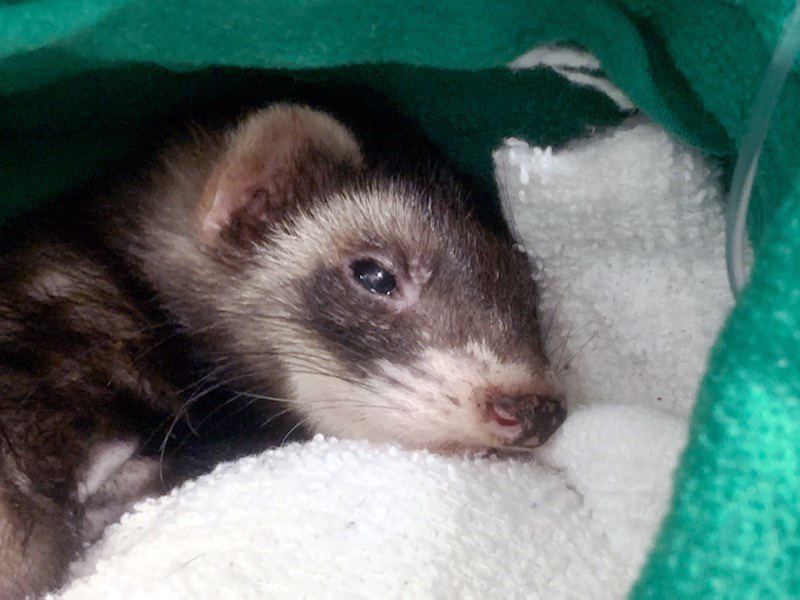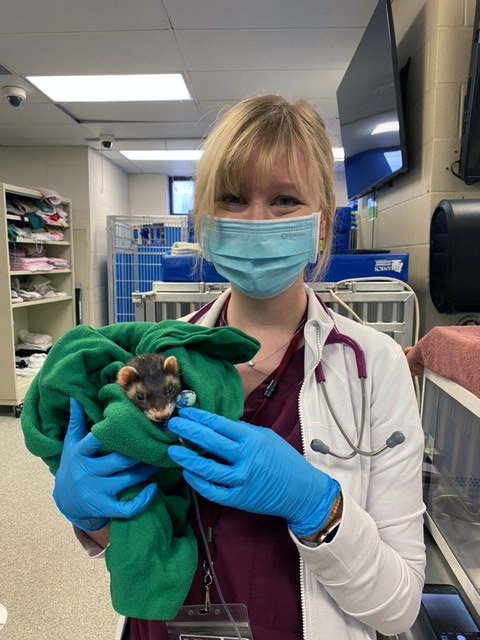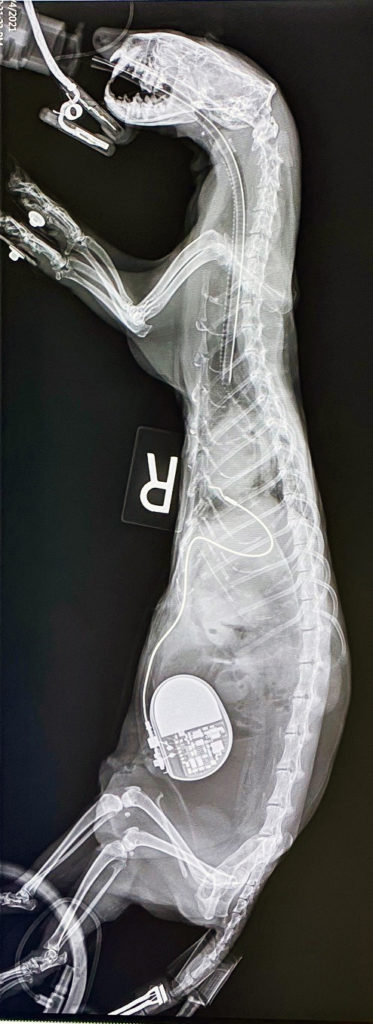Ferret Receives Lifesaving Pacemaker At Texas A&M SATH
Story by Megan Myers, VMBS Communications

It’s not every day that veterinarians at the Texas A&M Small Animal Teaching Hospital (SATH) get to sew a pacemaker onto a beating heart roughly the size of a grape. In fact, until March 2021, the procedure had only been done twice at the hospital.
But when Hypnos, a 5-year-old ferret, arrived at the SATH with a very slow heart rate, a team of more than a dozen veterinary specialists, technicians, and students took on the challenge of helping the beloved pet return home healthy to his owner and ferret friends.
And a challenge it was, as this was the first ferret pacemaker procedure at the SATH in almost 10 years.
Hitting The Books
Hypnos’ experience began when owner Charles Teel took him to Gulf Coast Veterinary Specialists in Houston after noticing signs of lethargy and gastrointestinal issues. Their exotics specialist Dr. Becky Pacheco performed an electrocardiogram and discovered that Hypnos had a pathologic arrhythmia, or abnormal heart rhythm, called third-degree AV block.
“That’s when, essentially, the top chamber and the bottom chamber of the heart aren’t talking to one another and the signal cannot get from the top to the bottom of the heart to tell it to beat,” said SATH veterinary resident Dr. Blakeley Janacek, Hypnos’ primary cardiology doctor. “If the electrical bridge between the two is out, then the heart does not beat nearly as fast as it should.”
The best course of treatment for this condition, which is also seen in people and many other animals, is the surgical implantation of a pacemaker to manage the heartbeat with electrical impulses.
Pacheco suggested bringing Hypnos to Texas A&M, where veterinary cardiologists implant pacemakers on a regular basis. Because most of these patients are dogs, however, the Aggie veterinarians began doing research right away to learn as much as possible about other pacemaker cases in ferrets; they learned the first was reported in 2006.
“That was homework that we all enjoyed,” Janacek said. “It was a fun adventure, with the benefit of getting to help a little guy.”
It Takes A Village

Once Hypnos arrived at the School of Veterinary Medicine & Biomedical Sciences (VMBS) for his operation, Janacek was joined by a large team of colleagues, including Dr. Ashley Saunders, a veterinary cardiologist and VMBS professor; Dr. Vanna Dickerson, a veterinary surgeon and VMBS assistant professor; Dr. Dalton Hindmarsh, an emergency & critical care veterinary resident; and Dr. Mauricio Lepiz, an anesthesiologist and VMBS clinical associate professor.
In addition, numerous other residents, technicians, and fourth-year veterinary students played a role in ensuring the success of Hypnos’ procedure.
“I was just a very small piece of the puzzle,” Janacek said. “It was really, really important that we had everybody in place and that we were able to work together. That’s one of the cool things about working here at Texas A&M.”
Although the SATH did not have an exotics specialist available for Hypnos’ case, Hindmarsh and Dr. Rachel Ellerd (a fourth-year veterinary student at the time) both had experience with ferrets and helped care for him before, during, and after the procedure.
“We wouldn’t have been able to bring him in if Dr. Hindmarsh was not so comfortable working with ferrets,” Janacek said. “Rachel was also a good resource for anyone who had general ferret husbandry questions. She was super comfortable handling him, so she was a big asset to the team.”
Ellerd, a recent graduate who is specializing in exotic pet medicine, felt that fate was on her side in that she happened to be doing her cardiology rotation when Hypnos arrived at the SATH, which typically does not see many exotic pets.
“I was able to use my background in exotics to help with his history-taking, physical exam, and treatment while he was here,” said Ellerd ‘21. “Being a part of the third ferret pacemaker surgery ever performed at Texas A&M and seeing so many specialists come together really made me excited for my future in exotic pet medicine.”
A Ticking Clock

As the surgery began, the veterinarians knew they would need to be extra careful while working on such a small animal, but they also needed to work quickly so Hypnos wasn’t under anesthesia for too long.
“The biggest concern was if the team could move fast enough, because once we start anesthesia, the heart rate can go down,” Janacek said. “It involves getting him anesthetized, positioned, prepped, and draped; a surgeon getting into his abdomen and then his chest to sew the pacemaker onto his heart; and plugging the battery in—all with the clock ticking.
“There were moments of stress, but everyone was so enthusiastic and willing to work to help save the patient that we just plowed ahead, doing our best to get him paced, awake, and home doing ferret-like things,” she said.
As time went on, the veterinary team showed the depth of their talents as they worked to get everything done in time.
“We have a tremendous anesthesia team that facilitates a lot of things in this hospital and helps a lot of different species. They’re fantastic—those are tiny little ferret vessels you’re talking about putting catheters in,” Janacek said. “And Dr. Dickerson was the surgeon who sewed the pacemaker onto a very, very tiny beating heart, which is a really tremendous feat.”
Once the pacemaker was attached to the outer walls of the heart, its lead was connected to a battery pack that was placed in Hypnos’ abdomen.
When preparing Hypnos for surgery, the veterinary team also discovered a tumor on his pancreas called an insulinoma that was causing low blood glucose. Luckily, this tumor was easily removed during the pacemaker procedure.
About two hours after the surgery began, Hypnos was stitched up and ready to begin his recovery.
Back To ‘Ferret-Like’ Things
Hypnos’ improvement was almost immediate. His blood glucose returned to normal levels within 48 hours of removing the tumor and he was already feeling playful the day after surgery.
Thanks to his new pacemaker, Hypnos’ heart will keep a steady rhythm at 120 beats per minute, allowing him to live the rest of his life without any danger from his heart condition.
Looking back, Janacek is proud of the team effort that went into ensuring Hypnos’ recovery, by both his veterinary team and devoted owner.
“He would not have had much of a life if we didn’t do the procedure,” Janacek said. “It was good that his owner was able and willing to pursue the surgery. Every ferret owner I’ve ever met has been extremely kind and cares a lot about their little ferrets, but Hypnos’ owner was uniquely dedicated.”
###
Note: This story originally appeared in the Summer 2022 edition of VMBS Today.
For more information about the Texas A&M College of Veterinary Medicine & Biomedical Sciences, please visit our website at vetmed.tamu.edu or join us on Facebook, Instagram, and Twitter.
Contact Information: Jennifer Gauntt, Director of VMBS Communications, Texas A&M College of Veterinary Medicine & Biomedical Sciences; jgauntt@cvm.tamu.edu; 979-862-4216


